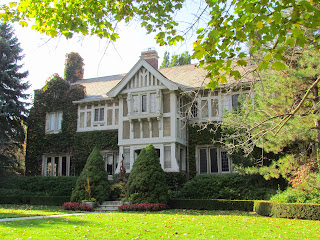Indeed, I ask John Blumenson, he of Ontario Architecture (Fitzhenry & Whiteside, 1990) and my travelling companion in 'Journeys with John' here in March of this year, or January 2014.
We turn to Mr. Blumenson to learn about the architectural style inspired by British precedents and known broadly as Period Revival, or more specifically as Tudor, or even Elizabethan or Jacobean Revival or that synthesis of inspiration, Jacobethan.
The English route to this revival is the rural manor houses and cottages of the Tudor period..."with the occasional high-style Gothic feature...the Tudor arch" or a "combination of Medieval forms with Classical elements reflecting the Elizabethan and Jacobean periods."
Period revival "refers to those twentieth century designs that reflect..this transitional era from the late Gothic to Tudor to the Jacobean periods."
We are talking about an era from 1485 - 1625! The year 1485 saw the accession of Henry VII, then Henry VIII and Elizabeth I reigned for most of the era from 1500 to 1603. It was the era of Shakespeare and the Globe Theatre, Henry VIII's nasty marital problems, the dissolution of the monasteries, the English Reformation. Life was improving, but education and sanitation were still for the few.
 |
| Elizabethan Revival - 12 Ravenscliffe (1910) |
Glass was expensive and hard to make, so small panes were held together with lead lattice. Tudor chimneys were tall and thin, or twisted, and decorated with cut brick designs.
So why this love affair with a time of "nasty, brutish and short" lives?
Elements common to the Period Revival include: steeply pitched gable roofs, cross gables, and dormer covered with shingles like thatch, Jerkin head gables, stone or brick walls with a projecting upper floor or jetty, half-timbering on upper floors, narrow casement windows with leaded panes, lintels imitating rough stone or wood, drip moulds, entrances with Tudor or round arch, sometimes parapet or shaped gables and transomed windows, and Classical elements like pilaster strips, columns, decorative strap work and stone banding on corners and window surrounds. (Blumenson pages 158-9)
Why indeed? I had to turn to another source, A Guide to Canadian Architectural Styles (Maitland, Hucker & Ricketts, Broadview Press, 1992) for a partial answer.
The authors suggest "a nostalgia for the past and an admiration of things British" and its "association with domesticity." Ironic that this enclave of exclusive homes in early twentieth century industrial giant Hamilton should express such admiration for the "pre-industrial, medieval crafts."
 |
| 18 Turner (1932) |
 |
| 358 Bay Street South (1930) |
 Each of these exquisite homes is within walking distance - I visited them all one sunny late fall afternoon in October. They can be revisited via Historical Hamilton's Durand site.
Each of these exquisite homes is within walking distance - I visited them all one sunny late fall afternoon in October. They can be revisited via Historical Hamilton's Durand site.








I'll have 358 Bay St S, please! Aren't these all such beauties? Brenda
ReplyDelete